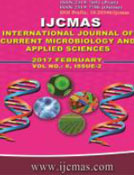


 National Academy of Agricultural Sciences (NAAS)
National Academy of Agricultural Sciences (NAAS)

|
PRINT ISSN : 2319-7692
Online ISSN : 2319-7706 Issues : 12 per year Publisher : Excellent Publishers Email : editorijcmas@gmail.com / submit@ijcmas.com Editor-in-chief: Dr.M.Prakash Index Copernicus ICV 2018: 95.39 NAAS RATING 2020: 5.38 |
Sclerotinia sclerotiorum is a temperate plant pathogen. It is soil borne and has a worldwide distribution. It affects cabbage leading to a diseased condition called head rot in which rotting of fully grown cabbage heads takes place. The rotted cabbage heads exhibit cottony white mycelial growth on their surface. With advancement of the disease the mycelial growth becomes dense and numerous carbon black coloured bodies called sclerotia are formed on the surface. Effect of temperature and salinity was studied to determine the optimum temperature for growth of the pathogen and the optimum salinity of soil tolerable for the pathogen growth respectively. Results indicated that temperature of 200C was the most optimum for the pathogen growth and formation of sclerotia. Growth of S. sclerotiorum was maximum at 1 per cent NaCl concentration. The growth of the pathogen decreased with increasing salinity levels. Thus the study demonstrated the optimum temperature and salinity for the pathogen growth.
 |
 |
 |
 |
 |